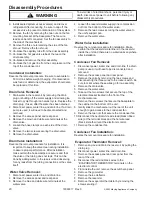
Component Testing
To avoid risk electrical shock, personal injury, or death,
always disconnect electrical power source to the freezer
before attempting to service, unless test procedures require
power to be connected. When removing any wiring from terminals they must be replaced on the same terminals.
Ensure all ground wires are connected before certifying unit as repaired and/or operational.
WARNING
!
©2003 Maytag Appliances Company
16022217 Rev. 0
11
Evaporator
The evaporator uses evaporating refrigerant to remove
heat from the water that flows over the evaporator plate
to form an ice slab. The ice slab will simply slide down
the evaporator plate onto the grid-cutter during harvest.
The evaporator plate will over time have a build up of
mineral deposits. The evaporator will
not
need to be
replaced due to the mineral deposits. These deposits
must be removed periodically for proper icemaker
performance.
The evaporator must also be free of nicks and
scratches. A nice polished and smooth evaporator will
allow the ice machine to perform correctly, giving the
best performance by allowing the ice slab to slide freely
and allowing the water to have proper evaporator to
water contact. If nicks and scratches are found,
replacement is not needed. Simply remove the nicks and
scratches with fine sanding material and then use a
polish for stainless steel.
If the evaporator has a leak, it should be replaced. A leak
detection device will confirm a leaking evaporator
assembly.
Note:
If a leak in the evaporator, accumulator, or low
side tubing is found, the compressor, drier, and
hot gas valve will need to be replaced.
The temperature control thermistor sets on the bottom of
the evaporator plate on a copper bracket. This bracket
should be checked at the solder joint. Any cracks will
break the proper thermal conductivity between the
evaporator plate and the thermistor and result in long
production cycle with a thick slab on the plate. The
thermistor should also be secured tight and have full
contact to the copper bracket or thermal conductivity
again will be sacrificed.
Compressor
The compressor is the heart of the refrigeration system.
It also, however, relies on other parts of the system to
function. Make certain that the other parts of the system
are correctly functioning before determining that the
compressor is faulty.
Note:
The compressor is protected from power
interruptions with a start delay built into the
control to
prevent high pressure startup DO
NOT mistake this for a faulty compressor.
The following must also be observed before concluding
the compressor is faulty:
1. Low high side pressures, warm evaporator plate, cool
condenser coil, or little or very low current draw from
the unit will indicate a faulty compressor.
2. Check for continuity between the compressor
terminals and the shell of the compressor. If
continuity is found, the compressor is faulty and will
need replaced.
3. Check for resistance between all three compressor
terminals. The resistance will vary from terminal to
terminal and from compressor to compressor due to
age and use. If no resistance is found, the
compressor is faulty and will need replaced.
Condenser
The condenser is a steel tube serpentine with copper
alloy fins, which removes heat from hot, high-pressure
vapor from the compressor. The most common trouble is
lack of airflow from either a restricted intake or exhaust
opening in the front of the unit. Lint, dust, hair, and dirt
build-up needs to be removed from the condenser
periodically to allow the unit to perform properly.
It is possible that the condenser might need replaced
because of an un-repairable leak or a restriction that
cannot be flushed out. System high side pressures and
temperatures will verify if this is the case.
Drain Valve
The drain valve drains water that is left in the reservoir
after ice production. The valve will only be open for a
fixed time of 45 seconds during the beginning of the
harvest cycle.
The drain valve fails by allowing water to flow into the
drain during the ice production cycle (leak-by). This is
can be caused by a foreign particle(s) or build-up of
mineral deposits that will not allow the valve to fully seat
or has caused damage to the seat of the valve. Periodic
cleaning of the icemaker will keep build-up off valve
allowing it to work properly and should be done before
further evaluation of the valve.












































